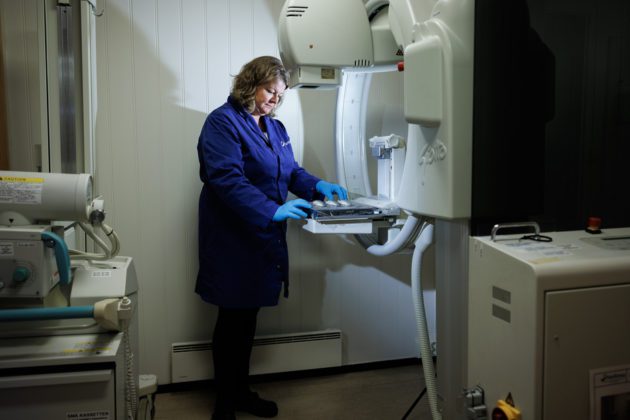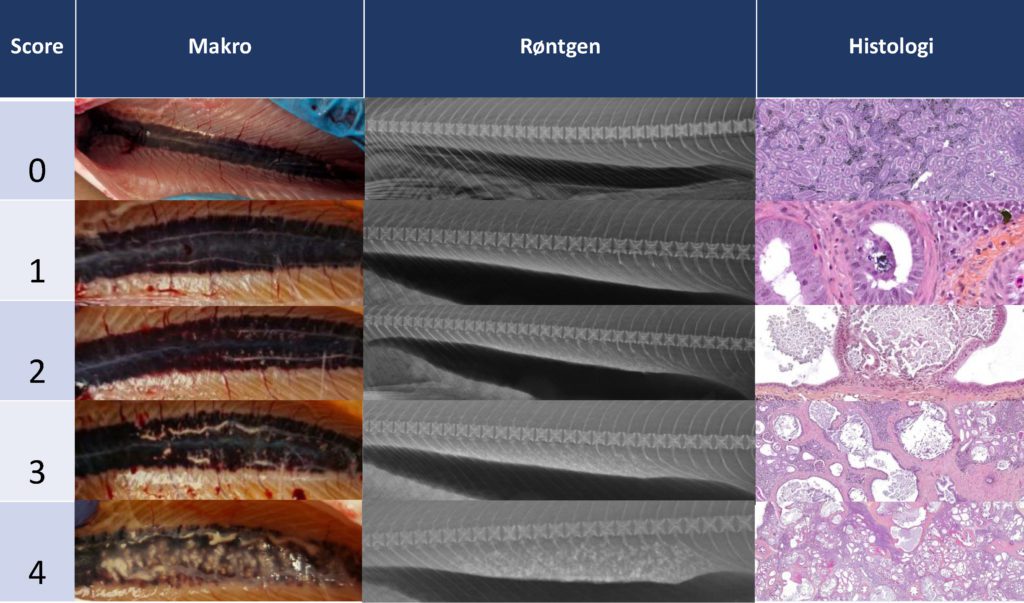Diagnosing nephrocalcinosis in the field

Fish health professionals have a bleak regard for nephrocalcinosis. It is a rapidly spreading kidney disease in salmonids that we currently do not know the extent or causes of. Nofima scientists have now further developed diagnostic methods so that they can determine the prevalence of salmon with nephrocalcinosis and its severity – in live fish in the field.
In this year’s Fish Health Report from the Norwegian Veterinary Institute, nephrocalcinosis is reported by most fish health personnel and the Norwegian Food Safety Authority to be an increasing issue, with high mortality rates and possibly severely reduced fish welfare.
Veterinarian Kirsti Hjelde is a Nofima scientist who works with the use of X-rays as a tool to map and study various production-related disorders in farmed fish.
“When fish health professionals all over Norway are worried about nephrocalcinosis, it should become a matter of concern for us scientists as well. More nephrocalcinosis is emerging in new operational contexts. When we are not always able to reproduce nephrocalcinosis in trials, it is an indication that the causes of this disease are complex”, says Hjelde.
What does nephrocalcinosis do to the fish?
The kidney filters the blood and is one of the major blood-forming and immunological organs in fish. When smolt are released into the sea with defective kidneys, they are less able to withstand the challenges in the sea environment. Nephrocalcinosis is an unnecessary burden. It is uncertain how painful it is, or when it becomes a truly serious condition.
“The fish can look great on the outside, but their kidneys are ruined. Kidneys essentially have considerable extra capacity, so one of the current challenges is to understand how this disease progresses, and how much the kidneys can tolerate before they are beyond repair. We believe we have found an intersection where things quickly get much worse, and this is something we hope to be able to follow up on with further research”, reveals Hjelde.
Need for mapping
There is currently no systematic screening for nephrocalcinosis in Norway. Nephrocalcinosis is mostly diagnosed in dead or abnormally weak and thin fish, but this would not reflect the actual prevalence in a population of live fish. X-ray diagnostic of nephrocalcinosis has long been used on mammals; what’s new with the Nofima researchers’ method is that X-ray screening can now be applied to fish on the production site. Nofima has adapted an existing diagnostic tool for practical use:
“The method has become so effective and the radiography systems so good that we can bring our equipment to the fish and run our diagnosis directly on the spot” says Hjelde.
Through Grete Bæverfjord’s research work, Nofima has had the ability to conduct large-scale X-ray diagnostics, including of live fish, for decades. Her colleague Kirsti Hjelde has validated X-rays against histology images of nephrocalcinosis. This provides her with diagnostics that is reliable and comparable against histological findings that can determine whether the fish has nephrocalcinosis, and to what extent.
“The diagnostic is watertight, but requires high image quality”, says Hjelde.
The methodology itself is published by Christine Klykken at Aqua Kompetanse and NTNU in her PhD. Hjelde’s work is based on the same methodology as Klykken’s, but Hjelde has further developed the diagnostics to be more practically applicable in the field.
Seeking coordination with other professional communities
As a first step, Hjelde believes that the ability to use the diagnostic tool in the field greatly advances the possibility of mapping the extent and further development of nephrocalcinosis. After that we can backtrack to investigate the causes of the present situation.
But first, it is key that everyone working on nephrocalcinosis diagnostics speaks the same language.
“I know several others who have bought X-ray equipment and run diagnostics of their own. All of us who are working on this issue need to coordinate in order to compare prevalence data and start finding the causes of this problem and how to address it.
Especially relevant in RAS systems
Nephrocalcinosis is a well-known issue in intensive rainbow trout farming, but is currently becoming more widespread for salmon as well, even appearing in many RAS systems.
“When we create new environments for the farmed salmon to live in, we need to make sure the conditions we provide are good”, says Hjelde.
Hjelde has collaborated with hatchery partners on the development of the diagnostics method.
“The more equipment you have available, the more it will be used, and the more information you get. The equipment has become relatively affordable and accessible. Now we need people who can use it. That should not be so difficult. If we who use it all speak the same language and join forces, we will gather so much more information than if we just keep doing our own thing in isolation”, Hjelde says hopefully.

Contact person
Research facilities
